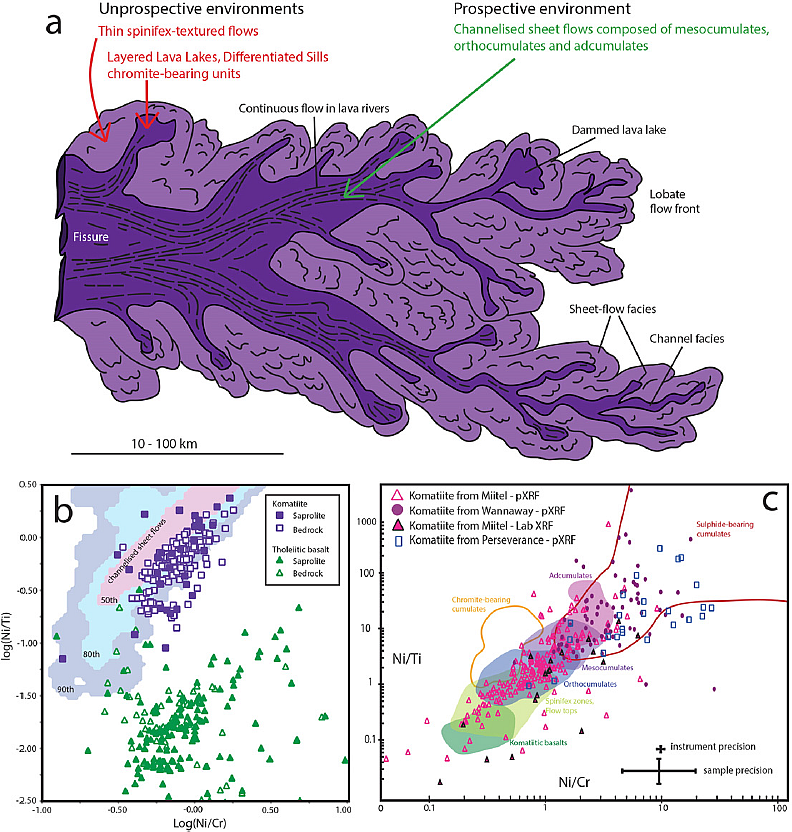What is this layer?
Ratios of Ni/Cr for ultramafic rocks, derived from the GSWA Geochemistry database. Ni/Cr ratios can be used to interpret the volcanic environment in which a system formed. Higher Ni/Cr ratios represent olivine-rich channel facies that are more prospective for nickel mineralization Le Vaillant et al. (2016).
Legend
|
Legend |
Range |
Classification |
Description |
Reference |
|---|---|---|---|---|
|
Ni/Cr SOURCE |
0–1 |
Manual |
Ni/Cr values between 0–1 represent less prospective rocks, likely to be komatiite basalts or spinifex-textured komatiites The applied ranges of ratio values are based on Figure 1c (from Le Vaillant et al., 2016) |
|
|
1–10 |
Manual |
Ni/Cr values between 1 and 10 represent more prospective rocks, likely to be cumulate-textured komatiites The applied ranges of ratio values are based on Figure 1c (from Le Vaillant et al., 2016) |
||
|
>10 |
Manual |
Ni/Cr values between 10 and 100 likely represent sulfide-bearing cumulates The applied ranges of ratio values are based on Figure 1c (from Le Vaillant et al., 2016) |
a) Schematic illustration of a regional komatiite flow field, modified from Hill et al. (1995)
b) Comparison of Ni/Ti and Ni/Cr ratios between fresh bedrock and top of fresh rock saprolite in the Agnew area in Western Australia, data compiled by Barnes et al. (2014)
c) Plot shows the potential use of pXRF in evaluating the prospectivity of a komatiite unit using Ni/Ti and Ni/Cr ratios, modified from Le Vaillant et al. (2014)
References
Barnes, SJ 1998, Chromite in Komatiites, 1. Magmatic controls on crystallization and composition: Journal of Petrology, v. 39, no. 10, p. 1689–1720, doi:10.1093/petroj/39.10.1689.
Barnes, SJ, Fisher, LA, Anand, R and Uemoto, T 2014, Mapping bedrock lithologies through in situ regolith using retained element ratios: A case study from the Agnew-Lawlers area, Western Australia: Australian Journal of Earth Sciences, v. 61, p. 269–285.
Barnes, SJ, Hill, RET, Perring, CS and Dowling, SE 2004, Lithogeochemical exploration of komatiite-associated Ni-sulfide deposits: Strategies and limitations: Mineralogy and Petrology, v. 82, p. 259–293.
Hill, RET, Barnes, SJ, Gole, MJ and Dowling, SJ 1995, The volcanology of komatiites as deduced from field relationships in the Norseman-Wiluna greenstone belt, Western Australia: Lithos, v. 34, p. 159–188.
Le Vaillant, M, Barnes, SJ, Fisher, L, Fiorentini, ML and Caruso, S 2014, Use and calibration of portable X-Ray fluorescence analysers: Application to lithogeochemical exploration for komatiite-hosted nickel sulphide deposits: Geochemistry: Exploration, Environment, Analysis, v. 14, p. 199–209.
Le Vaillant, M, Fiorentini, ML and Barnes, SJ 2016, Review of lithogeochemical exploration tools for komatiite-hosted Ni–Cu–(PGE) deposits: Journal of Geochemical Exploration, v. 168, p. 1–19, doi:10.1016/j.gexplo.2016.05.010.

